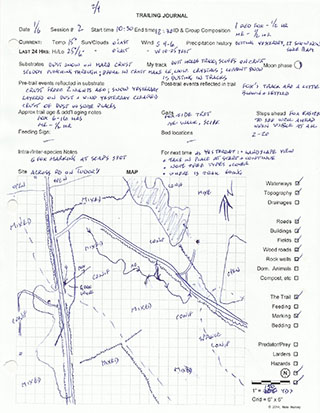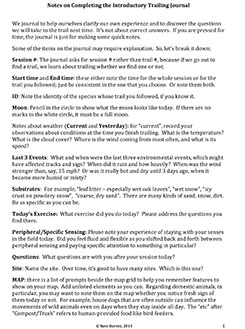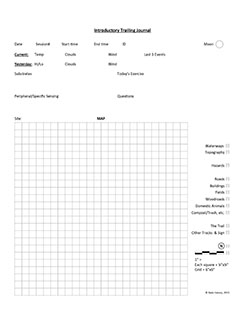Journaling: Building Landscape Literacy
 Whether we are beginners or experts, keeping a journal helps our thinking – and our sight – to be as clear as possible when we are in the field. Clear thinking enables us to trail safely to a living wild animal.
Whether we are beginners or experts, keeping a journal helps our thinking – and our sight – to be as clear as possible when we are in the field. Clear thinking enables us to trail safely to a living wild animal.
When we are learning to trail animals, there is only one really meaningful practice, and that is to follow trails.
The ability to follow trails is not a single skill, however, but rather, it requires a variety of skills. So, the one general practice of following trails can be broken into a number of routines that we practice at the same time. The intention of the Trailing Journal is to draw awareness to those routines in order to help us build good habits, become more efficient and see more clearly what is in front of us.
If, for example, I make a habit of noting the moon's phase every time I return from the field, then it will become part of my consciousness when I am out there. The situation may come up where I wonder if the deer I am following avoided a particular open area in the woods in order to stay out of moonlight. If I neglect my awareness of the moon phase, that question may not occur to me, and I miss the behavior that is in front of my eyes.
There is more: the journal does not just help us to remember routines but is also a way to tell the story of the trail, to recall not just a stretch of tracks. As I draw my map, I think, "by the spring was that big oak and beyond it to the west the old foundation; a wood road; a field edge where the animal stayed just inside the woods – was it avoiding the moonlight? – all the way around one end of the field; a scat – coyote? – where the animal paused; a place where the animal started to run – did it sense me? – wait, could those tracks have been fresh enough that it picked me up? – I have to remember to look more closely for freshness next time." Journaling our time in the field helps us to bring home the fullness of our experience and so, makes it more available to us.

 The Introductory Trailing Journal and its accompanying page, which explains how to complete it.Do not skip the journal, as it becomes your place to interpret uncertain signs, learn from your own story and build your landscape literacy.
The Introductory Trailing Journal and its accompanying page, which explains how to complete it.Do not skip the journal, as it becomes your place to interpret uncertain signs, learn from your own story and build your landscape literacy.
The few minutes that it takes each time you fill one out will make your field work far more efficient and save you lots of time overall.
The more completely you write the journal on a regular basis, the more you will get out of it. It is better, though, to be brief & regular than highly detailed & irregular.
Here is the journal that accompanies the Introductory exercises. For those students who enroll in the full Trailing Wildlife curriculum, there is also an appropriate journal that accompanies each of the Beginner, Intermediate and Advanced sections.
© Nate Harvey, 2015
